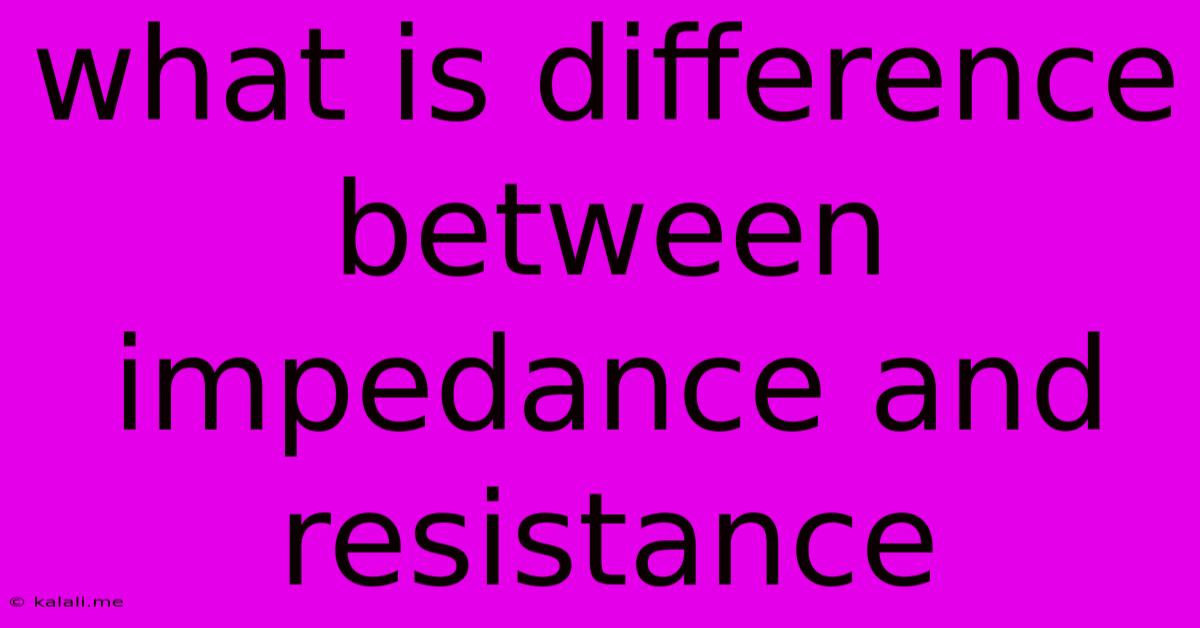What Is Difference Between Impedance And Resistance
Kalali
Jun 13, 2025 · 3 min read

Table of Contents
What's the Difference Between Impedance and Resistance? A Deep Dive
Understanding the difference between impedance and resistance is crucial for anyone working with electricity, particularly in AC circuits. While both oppose the flow of current, they do so in fundamentally different ways. This article will delve into the core distinctions, explaining each concept clearly and concisely. This will help you understand the underlying physics and improve your ability to troubleshoot electrical systems.
Resistance, often represented by the symbol R, is the opposition to the flow of direct current (DC) in a circuit. It's a simple concept: a higher resistance means a lower current for a given voltage. Resistance is measured in ohms (Ω) and is always a positive, real number. Think of it as friction in a water pipe – the narrower the pipe, the greater the resistance to water flow. In purely resistive circuits, the voltage and current are in phase; they rise and fall together.
Impedance, represented by the symbol Z, is a more comprehensive concept encompassing resistance but also extending to the opposition to the flow of alternating current (AC). Unlike resistance, impedance is a complex number, meaning it has both magnitude and phase. This is because AC circuits often involve components like capacitors and inductors, which introduce phase shifts between voltage and current. These components react to the changing voltage and current, adding another layer of opposition beyond simple resistance.
Here's a breakdown of the key differences:
Key Differences Between Resistance and Impedance:
| Feature | Resistance (R) | Impedance (Z) |
|---|---|---|
| Type of Current | Direct Current (DC) | Alternating Current (AC) |
| Unit | Ohms (Ω) | Ohms (Ω) |
| Nature | Real number | Complex number (magnitude & phase) |
| Components | Resistors | Resistors, capacitors, inductors |
| Frequency Dependence | Independent of frequency | Dependent on frequency |
| Phase Relationship | Voltage and current are in phase | Voltage and current are out of phase |
Understanding Impedance in AC Circuits:
In AC circuits, capacitors and inductors introduce reactance, which contributes to the overall impedance.
-
Capacitive Reactance (Xc): Capacitors oppose changes in voltage. The reactance is inversely proportional to frequency; higher frequency means lower capacitive reactance.
-
Inductive Reactance (Xl): Inductors oppose changes in current. The reactance is directly proportional to frequency; higher frequency means higher inductive reactance.
The total impedance (Z) in an AC circuit is calculated using the following formula (for a simple series circuit with R, L, and C):
Z = √(R² + (Xl - Xc)²)
This formula highlights how resistance and the difference between inductive and capacitive reactance determine the total impedance. The phase angle, representing the phase difference between voltage and current, is given by:
θ = arctan((Xl - Xc)/R)
Practical Implications:
Understanding the distinction between resistance and impedance is critical in various applications:
- Circuit Design: Accurate impedance calculations are essential for designing efficient and stable AC circuits.
- Signal Processing: Impedance matching is crucial for optimal power transfer in audio and RF systems.
- Power Systems: Impedance is a key parameter in analyzing power transmission lines and transformers.
- Troubleshooting: Identifying impedance mismatches can help pinpoint problems in electrical systems.
In conclusion, while resistance describes the opposition to DC current flow, impedance is a broader concept describing the opposition to AC current flow, considering both resistance and reactance. Understanding this crucial difference is fundamental to working effectively with electrical circuits.
Latest Posts
Latest Posts
-
Which Cycle Is Not A Major Biogeochemical Cycle
Jun 14, 2025
-
Good Conductor Of Heat And Electricity Metal Or Non Metal
Jun 14, 2025
-
Which Of The Following Statements About Interjections Is False
Jun 14, 2025
-
What Is The Lcm Of 2 And 11
Jun 14, 2025
-
How Are Protists And Bacteria Different
Jun 14, 2025
Related Post
Thank you for visiting our website which covers about What Is Difference Between Impedance And Resistance . We hope the information provided has been useful to you. Feel free to contact us if you have any questions or need further assistance. See you next time and don't miss to bookmark.